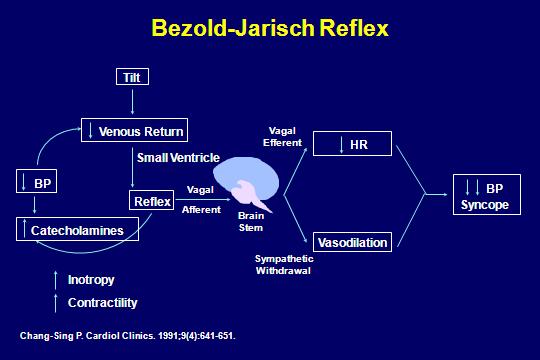Bezold-Jarisch reflex clinical correlation
Jump to navigation
Jump to search
Template:Bezold-Jarisch reflex
Editor-In-Chief: C. Michael Gibson, M.S., M.D. [1]; Associate Editor-In-Chief: Cafer Zorkun, M.D., Ph.D. [2]; Rim Halaby, M.D. [3]; Mugilan Poongkunran M.B.B.S [4]
Overview
Clinical Correlation
Bezold-Jarisch reflex plays a role in the following clinical conditions:
- Bradycardia, hypotension and gastrointestinal symptoms with inferoposterior myocardial infarction
- Exertional syncope in aortic stenosis
- Neurohumoral activation in chronic heart failure
- Reperfusion induced bradycardia and hypotension during coronary catheterization
- Therapeutic benefits of digitalis
- Vasovagal syncope[1]
Acute Inferoposterior Myocardial Infarction
- Bezold-Jarisch reflex is responsible for 61% of bradyarrhythmia that occur within the first 60 minutes of MI,[2] and it explains the occurrence of AV node block in the context of acute posterior or inferior myocardial infarction.[3]
- It is hypothesized that this reflex is a protective reflex that vasodilates the coronary arteries in the setting of posterior infarction associated with coronary vasospasm.[4]Bradycardia in this setting may be treated with atropine.
Reperfusion
- Bezold-Jarisch reflex can occur in acute inferior MI after thrombolysis. In fact, it is a prognostic sign for early reperfusion as it occurs in 94% of cases of successful early thrmobolysis in inferior MI.
- In addition, it is a prognostic factor for coronary patency as it occurs in 89% of patent right coronary artery characterized by aTIMI flow grade of 3.[5]
Vasovagal Syncope
- Prolonged upright posture results in some degree of pooling of blood in the lower extremities that can lead to diminished intracardiac volume. This phenomenon is exacerbated if the individual is dehydrated. The resultant arterial hypotension is sensed in thecarotid sinus baroreceptors, and efferent fibers from these receptors trigger sympathetic autonomic signals that increase cardiac rate and contractility. However, pressure receptors in the wall and trabeculae of the underfilledleft ventricle may then sense the stretching and contraction of the poorly filled ventricle, activating high-pressure C-fiberafferent nerves from these receptors. They may respond by activating the parasympathetic system that triggers paradoxicalbradycardia and decreased contractility, resulting in additional and relatively sudden arterial hypotension. Hence, Bezold-Jarisch reflex results from the stimulation of vagal afferent pathways in response to sympathetic overactivity.
- Inappropriate Bezold- Jarisch reflex must be suspected in the setting of unexplained syncope and should be investigated by tilt table test.
Below is an image that illustrates the mechanism of Bezold-Jarisch reflex in syncope.

Medication Effect
Anesthesia
- The Bezold–Jarisch reflex has also been suggested as a possible cause of profound bradycardia and circulatory collapse after spinal anesthesia.[7]
- Also, it is one of the complications of interscalene brachial plexus block.
Below is an image that illustrates the distribution of opioid OP4 receptors involved in the regulation of cardiovascular function.
![Distribution of opioid OP4 receptors involved in the regulation of cardiovascular function. Various locations of OP4 receptors as suggested by functional studies are shown. Excitatory neurons are represented by solid lines, inhibitory neurons are represented by dotted lines. Abbreviations: CVLM - caudal ventrolateral medulla; NAmb - nucleus ambiguus; NTS - nucleus tractus solitarii; PVN - paraventricular nucleus; RVLM - rostral ventrolateral medulla.[8]](/images/6/61/BJR.jpg)
References
- ↑ Mark AL (1983). "The Bezold-Jarisch reflex revisited: clinical implications of inhibitory reflexes originating in the heart". J Am Coll Cardiol. 1 (1): 90–102. PMID 6826948.
- ↑ Goldman, Lee; Anderson, Jeffrey L. "ST SEGMENT ELEVATION ACUTE MYOCARDIAL INFARCTION AND COMPLICATIONS OF MYOCARDIAL INFARCTION". Goldman: Goldman's Cecil Medicine (24th ed.). Saunders, an imprint of Elsevier Inc. p. 444. ISBN 978-1-4377-1604-7.
- ↑ Katz, Arnold M. (2001). Physiology of the heart (3. ed. ed.). Philadelphia [u.a.]: Lippincott Williams & Wilkins. p. 595. ISBN 0-7817-1548-2.
- ↑ Linden R.J. Function of Cardiac Receptors. Circulation. 1973; 48: 463-480
- ↑ Chiladakis JA, Patsouras N, Manolis AS (2003). "The Bezold-Jarisch reflex in acute inferior myocardial infarction: clinical and sympathovagal spectral correlates". Clin Cardiol. 26 (7): 323–8. PMID 12862298.
- ↑ eMedicine - Syncope : Article by M Silvana Horenstein, MD
- ↑ Tsai T. & Greengrass R. (2007). Textbook of Regional Anesthesia and Acute Pain Management: Spinal Anesthesia. (A. Hadzic, Ed.). New York: McGraw Hill Medical.
- ↑ Malinowska B. Godlewski G, Schlicker E. FUNCTION OF NOCICEPTIN AND OPIOID OP4 RECEPTORS IN THE REGULATION OF THE CARDIOVASCULAR SYSTEM, 2002, Bialystok, Poland